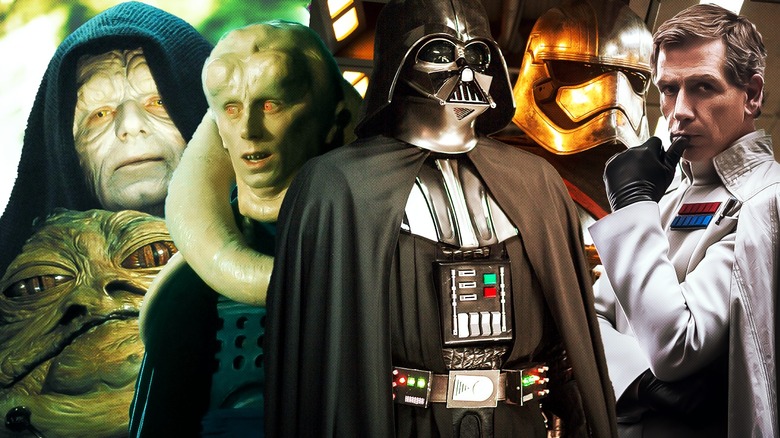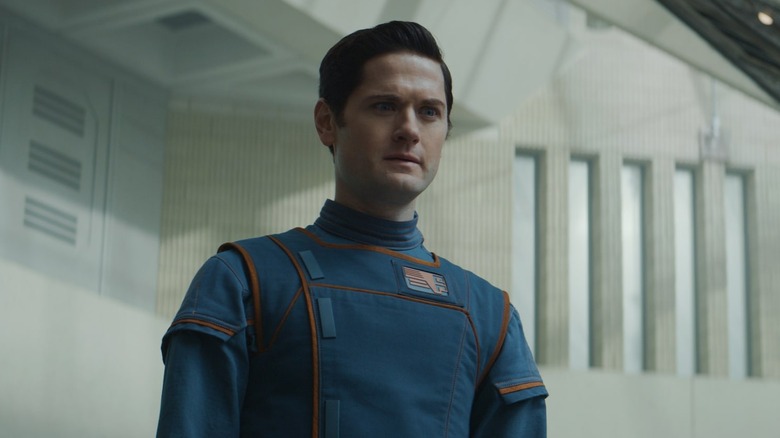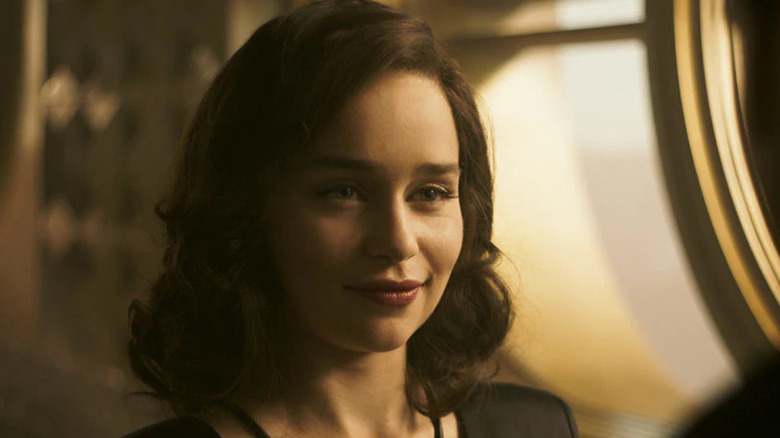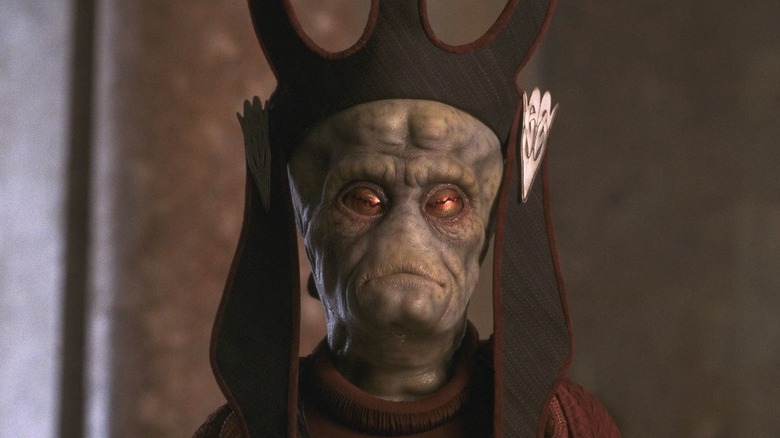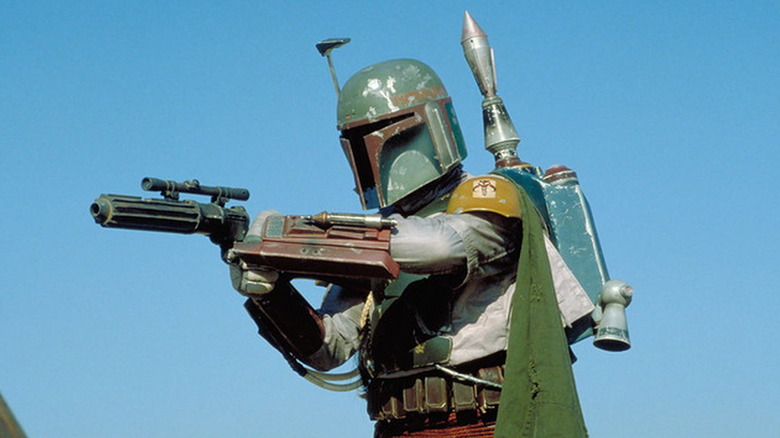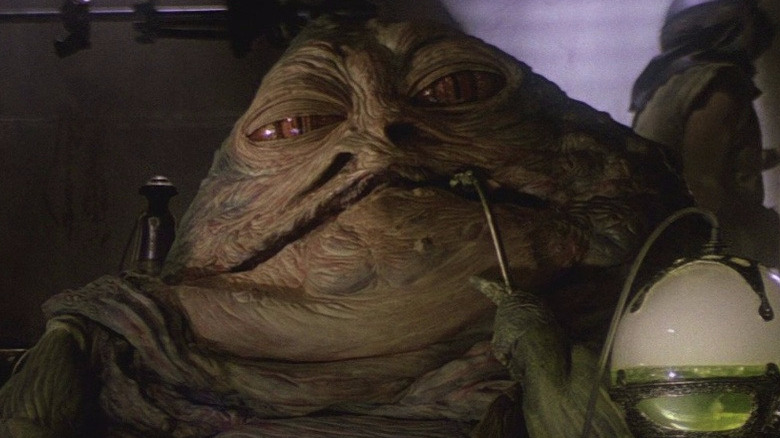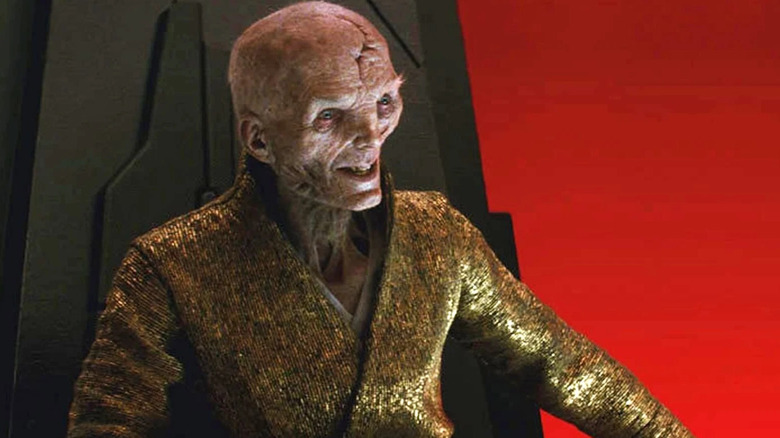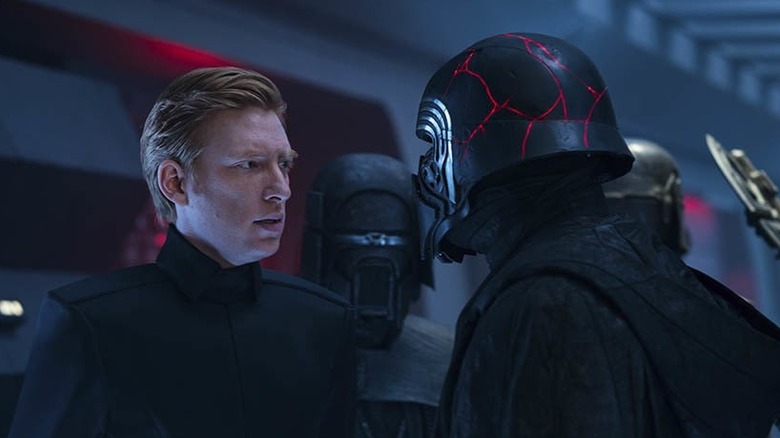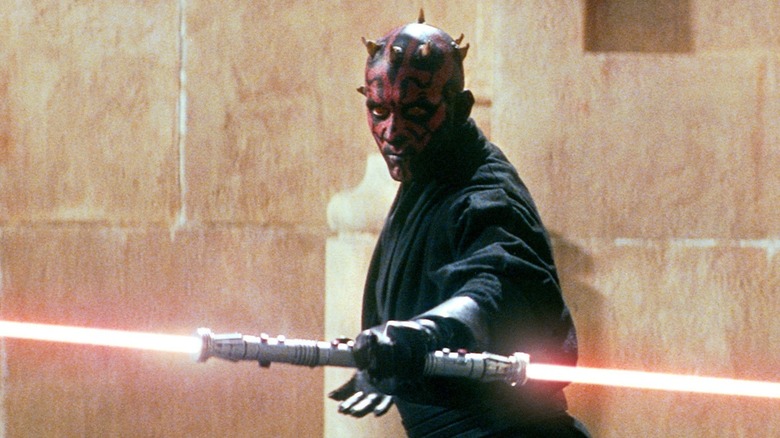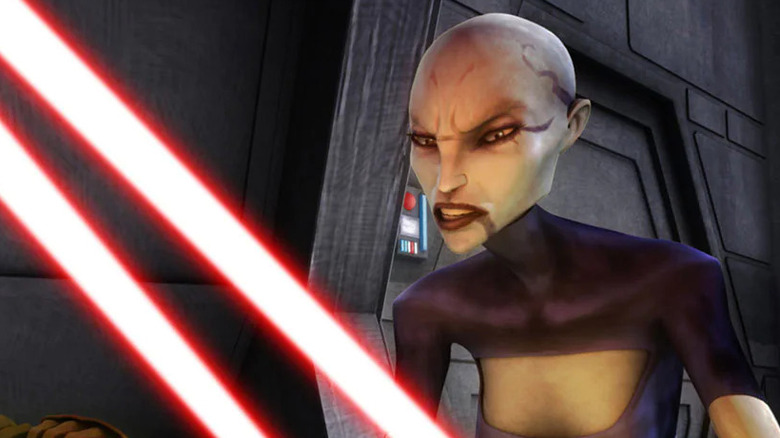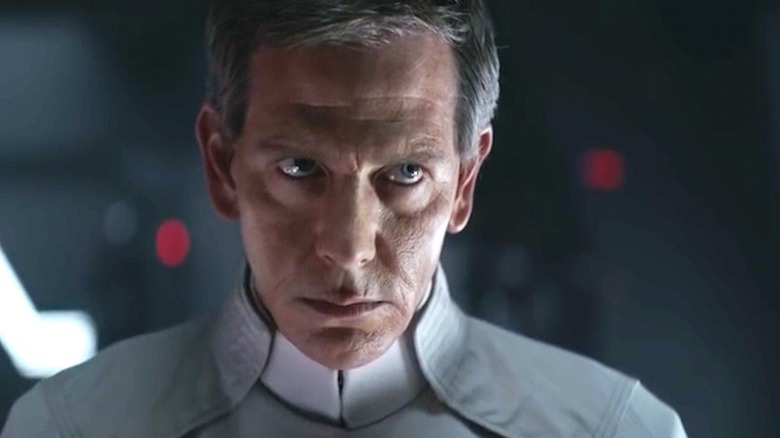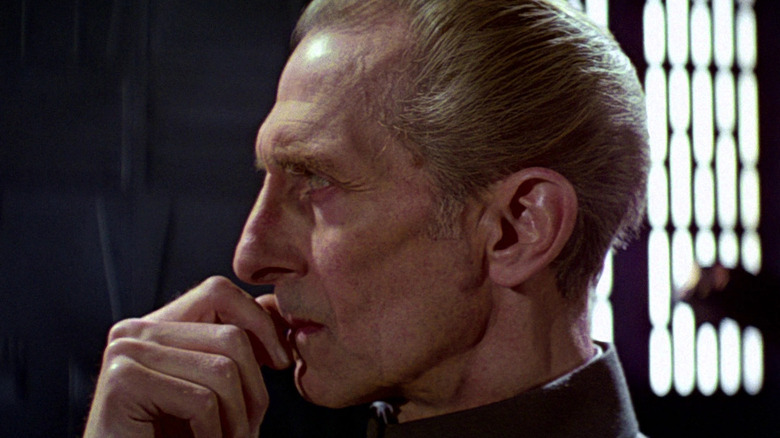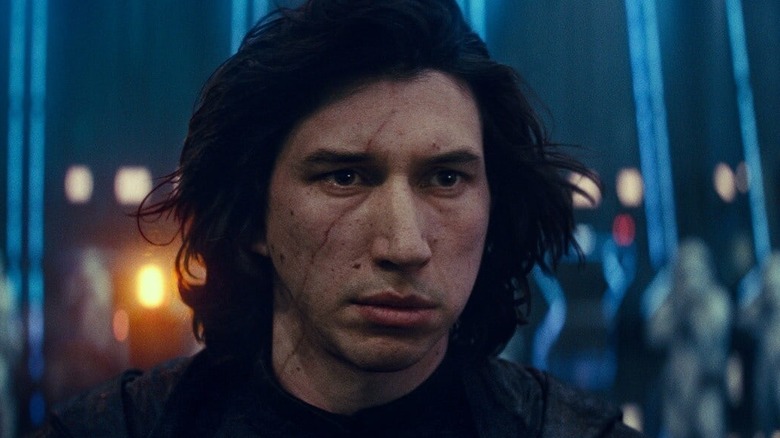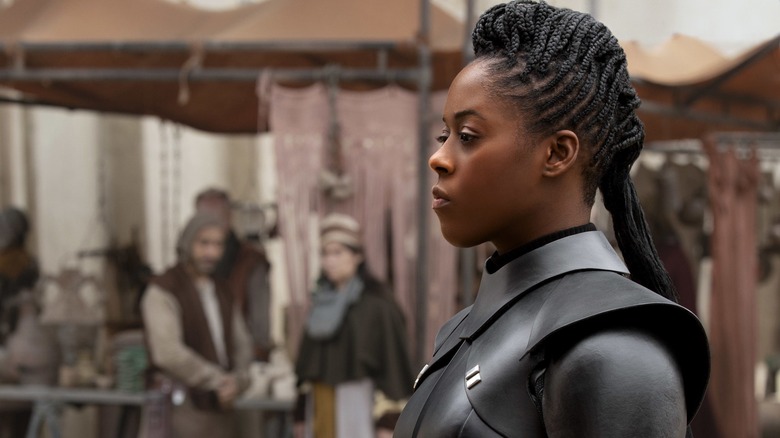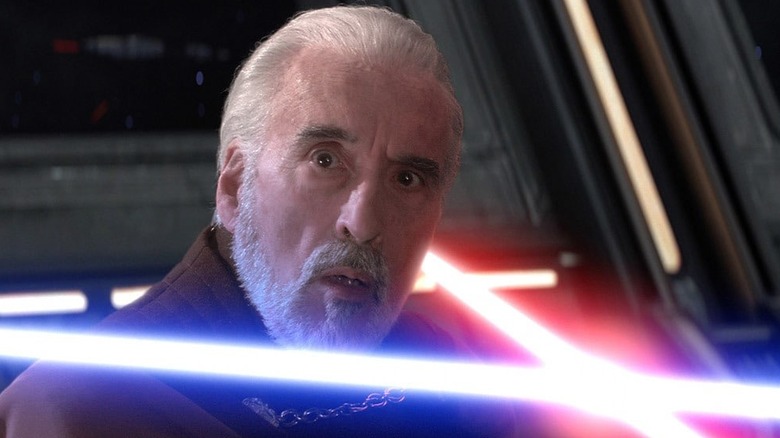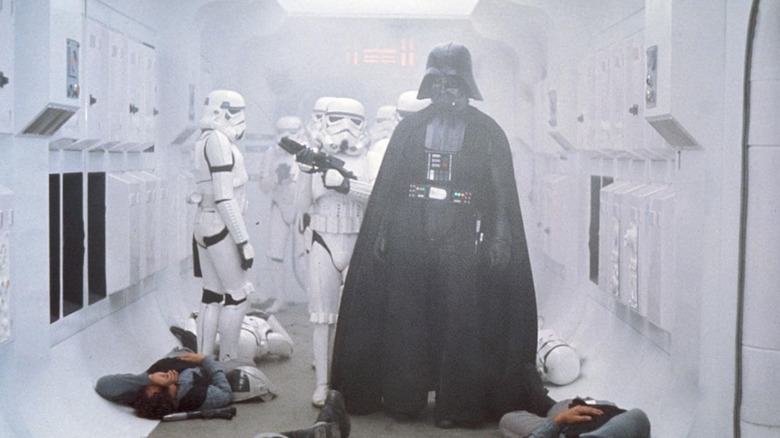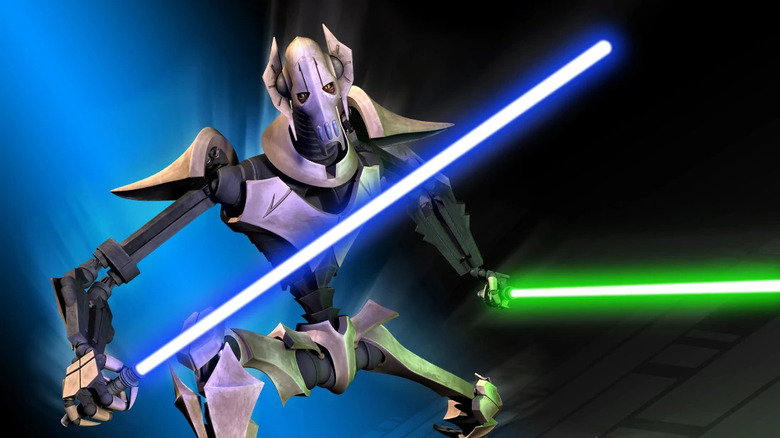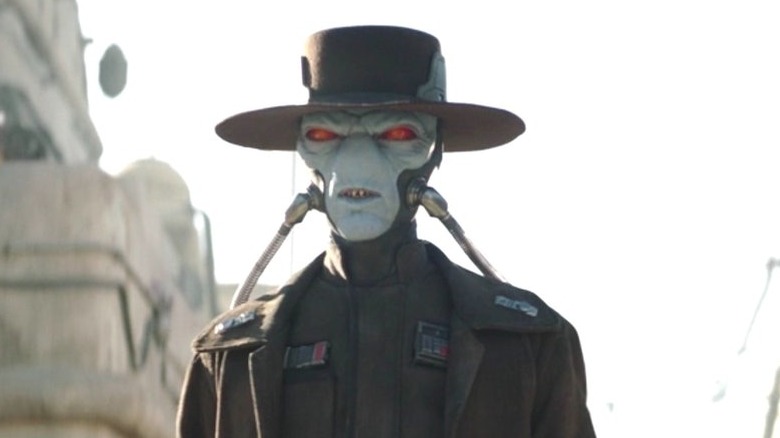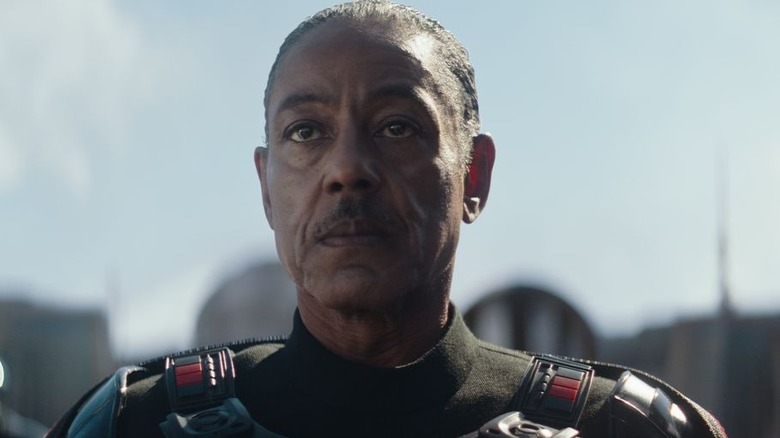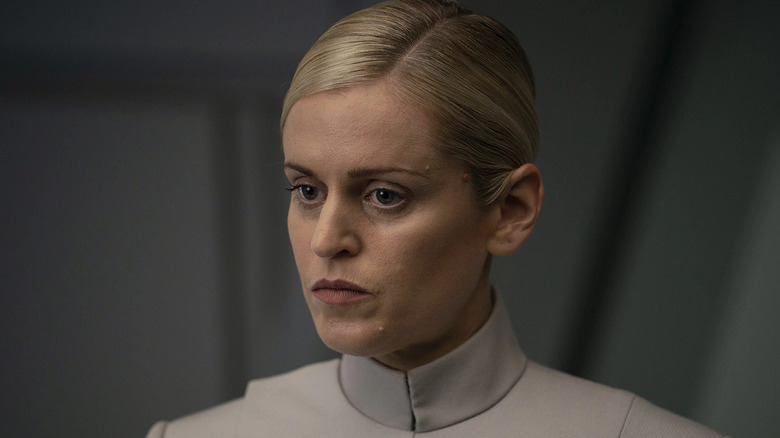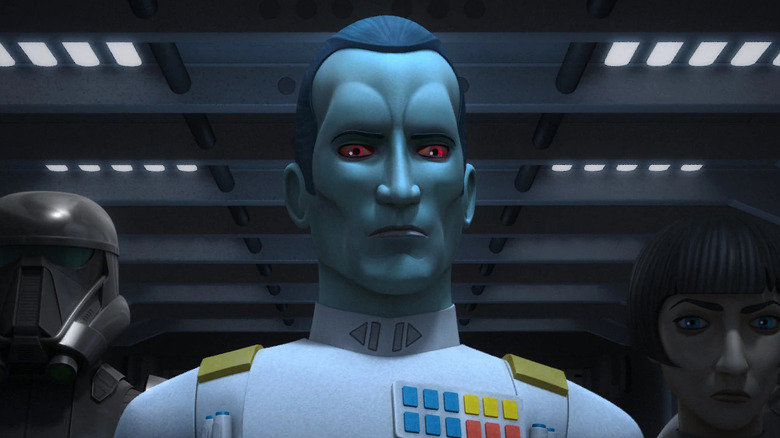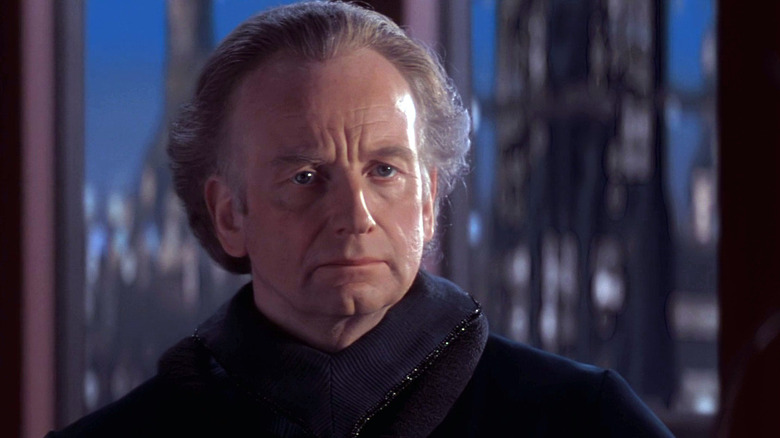Every Major On-Screen Star Wars Villain Ranked By Ruthlessness
If there's one thing that most canonical "Star Wars" villains have in common, it's that they are probably pretty ruthless. It wasn't until the third film, "Return of the Jedi," that audiences even saw a glimmer of humanity in any villain, and Darth Vader only had a change of heart at the last possible second to save Luke's life from the Emperor. The Empire was more of a faceless, authoritarian terror machine with a lot of unremarkable cogs. Then, in the prequels, the individual antagonists were mostly just Sith apprentices working alongside their master Palpatine.
But ever since Disney acquired Lucasfilm, there has been a huge influx of both live action animated content set in the "Star Wars" universe. Thanks to new movies like "Rogue One: A Star Wars Story" and shows like "The Mandalorian," audiences are seeing more complex antagonists than ever before. Every new villain in a "Star Wars" property demonstrates their own new and creative ways to be ambitious in advancing their personal agenda, which more often than not also aligns with that of the Empire. Let's take a look at the major baddies of "Star Wars" not just in terms of how memorable or compelling they are, but in just how ruthless each one is compared to the rest.
Bib Fortuna
Bib Fortuna is probably the least "major" of the major villains on our list, but he rates inclusions thanks to his involvement both in the original film trilogy as Jabba the Hutt's right-hand man and in the Disney+ TV shows, where his death at the hands of Boba Fett served as the driving action behind "The Book of Boba Fett." Bib Fortuna is sort of like the last stick of celery left on a plate of buffalo wings; he seems pretty insignificant but still serves a clear purpose. Specifically, he provides a juxtaposition to the more ruthless villains in the crime syndicates and Imperial institutions that pervade the galaxy.
Bib Fortuna's main goal is clearly survival, and he doesn't usually go out of his way to start fights or make his ambitions known. His ruthlessness comes from being weak and selfish — he's an opportunistic yes-man whose morals always align with the person providing him safety at any given moment. He's not really that evil on a grand scale, but he definitely enables evil behavior from his boss, Jabba the Hutt.
Syril Karn
Syril Karn is a very, very, very unlikeable man whose purpose in the narrative of "Andor" seems to be to creep people out and provide an example of someone who has fully embraced the radical conservatism of the Empire. Karn is the good soldier who has bought into the Empire's rhetoric of order vs. chaos so deeply that it backfires a bit — he has actually started to see the hypocrisy in a lot of how the Empire goes about its business.
In the first episode of "Andor," Karn is upset to discover that certain Imperial officials consistently get away with chaotic behavior. When he still wants to investigate the deaths of two such officials, his boss essentially tells him to sweep it under the rug in order to prevent anyone from looking more closely at how little law enforcement seems to care about enforcing the law within its own ranks.
Karn believes he is righteously ruthless, that he is one of only a few who understands the truth of the galaxy, and that he must help to bring about the authoritarian dream he was sold. Why Karn actually ranks so low on the list, despite how he views himself, is because he's not actually lucid enough to be effective. He has been both weaponized and lobotomized by the Empire's propaganda machine, and as such he's just not self-aware in enough to do a lot of damage on his own. He's really more of a tool for other, smarter villains.
Qi'ra
Like Bib Fortuna, a lot of Qi'ra's ruthlessness comes from her desire to just survive each day. In "Solo: A Star Wars Story," Qi'ra is Han's partner in crime and romantic interest on a planet called Corellia. They're desperate to escape their indentured servitude, but only Han is able to get away. Years later, Han runs into her on the private ship of Crimson Dawn leader Dryden Vos. Qi'ra is serving as a lieutenant in Vos' criminal organization, and is assigned to assist Han and his crew in obtaining a valuable substance called coaxium.
Throughout the film, Qi'ra works with Han and company on their mission and displays many skills in persuasion, deception, and combat. While she doesn't really say what she's been doing while she and Han have been apart, she does imply that it's been a long, dark road for her from Corellia.
Qi'ra allows Han to make the right decision about the coaxium at the end of the film, but after killing Dryden Vos herself, she tricks Han into leaving the crime lord's ship and takes off without him. Qi'ra has decided to become the leader of Crimson Dawn rather than run away with Han — a ruthless move if ever there was one. But despite leaving Han heartbroken, it's clearly what she believes to be the right path for both of them. Here's hoping Disney gives us a solo series for Qi'ra someday so we can see more of her ruthless, tactical decision-making.
Nute Gunray
Nute Gunray is a coward and a bureaucrat, in that order. As Viceroy of the Trade Federation, Gunray is instrumental in the assault on Naboo that takes place in "The Phantom Menace" and a rival of Queen Padme Amidala. Gunray, secretly working under orders from Darth Sidious, invades Naboo with the Trade Federation's droid army after having already executed a successful blockade of the planet.
Gunray is a puppet for Darth Sidious, who uses the Viceroy to initiate a crisis that leads to his takeover of the galactic senate as Chancellor Palpatine. He's not particularly significant, but he does still order the subjugation and starvation of Naboo's population in response to a trade dispute with the planet, which is very ruthless, dark influence or not.
In "Attack of the Clones," Gunray, after his total defeat on Naboo at the end of "The Phantom Menace," has aligned himself with Count Dooku and the separatists. He doesn't do very much in the movie, but as soon as he finds out that Padme Amidala (who is now Naboo's representative senator on Coruscant) is on Geonosis, he demands her head. The guy may not hold much power in the grand scheme of the galaxy, but he can definitely hold a grudge.
Boba Fett
Boba Fett was an antagonist in the original trilogy, but that was because Jabba and the Empire payed better than the other side. "Attack of the Clones" reveals that after witnessing the violent death of his father, Jango Fett, Boba would go on to become a near-silent, widely-feared bounty hunter dead set on being the best of the best.
Boba's skill, cunning, and ruthlessness allows him to tail Han Solo and Princess Leia and alert the Empire to their location, and that's why he doesn't rank dead last on the list. He's the man responsible for the biggest setback that the rebellion faces throughout the original trilogy. But, in "Return of the Jedi," Boba goes down pretty quickly as one of Jabba's doomed henchmen, getting his blaster sawed in half by a lightsaber before falling into the Sarlacc pit.
Ultimately, Boba Fett becomes a protagonist himself in the Disney+ series "The Book of Boba Fett" after helping Din Djarin and Grogu find their way in the galaxy. We get to see how he becomes a better man in his life with the Tusken Raiders, but that experience also seems to dampen much of his ruthless instinct.
Jabba the Hutt
Jabba the Hutt's evil isn't as widely spread as many of the other villains on this list, but he has enough power to enact quite a bit of cruel and unusual punishment on his enemies. His interests aren't in galactic politics so much as they are in maintaining his criminal enterprises and quality of life as Daimyo of Mos Espa on the planet Tatooine. Unfortunately for the Rebellion, Han Solo finds himself caught in Jabba's crosshairs.
From the safety and comfort of his dank, dark lair, Jabba the Hutt manages to harm all three of the main protagonists of the original "Star Wars" trilogy in the first half hour of "Return of the Jedi." Jabba keeps Han Solo, frozen in carbonite with an expression of horror, displayed in his main room. Leia attempts to rescue Han but is found out by Jabba, who then enslaves her in chains and forces her to wear a metal bikini, simply to disrespect and disgrace her.
Later Jabba tries to feed Luke and Han to his pet rancor, and when that fails — rather than use a blaster and get it over with — Jabba has his whole entourage travel out into the Tatooine desert in order to witness Han and Luke's feeding to the Sarlacc pit. Jabba the Hutt is nasty and ruthless, and would rank far higher on this list if his ambitions reached beyond wealth and pleasure.
Supreme Leader Snoke
Supreme Leader Snoke is definitely an unusual villain in the "Star Wars" canon. You can read more in-depth about the truth behind Snoke's origin, but the most important thing to know is that his purpose and origin seem to play differently in each of the three sequel movies. In "The Force Awakens," Snoke is set up by writer-director J.J. Abrams as the Supreme Leader of the First Order and Kylo Ren's Sith master.
In Rian Johnson's follow-up "The Last Jedi," Kylo Ren turns on the abusive Snoke instead of executing Rey. It's an interesting choice from Johnson to kill off the Supreme Leader, especially knowing it was his dark whispers that turned Kylo Rey to the dark side (meaning Snoke was pretty powerful). But it's after his death that his backstory really goes off the rails.
As Abrams and company revealed in the saga-capper "The Rise of Skywalker," Snoke was apparently a clone created by a clone of Palpatine (aka Darth Sidious) after the fall of the Empire. Snoke had free will, but he was either genetically engineered to reach for certain goals by Sidious or Sidious influenced Snoke's actions from afar via the dark side. Because of this, Snoke doesn't actually rank very high in the "Star Wars" rogues' gallery, but he still does quite a bit of damage as Supreme Leader, if the Resistance's fight throughout the three sequels is any indication.
General Hux
General Hux is a truly nasty person, and Domhnall Gleeson really finds the perfect scowl to display whenever he steps into the role. General Hux is a true believer in the First Order and its fascistic methods, but he lacks the imagination that he would need to become more than just a glorified lackey. He wouldn't (and in "The Force Awakens," he doesn't) hesitate to destroy an entire planet. He despises the Resistance and just about everyone else, based on his general demeanor, but he's also just uncool and often played as a joke throughout the sequel trilogy.
Try as he might, Armitage Hux isn't a real leader, and even though he makes an attempt to take over leadership of the First Order after Snoke's death, he folds pretty quickly when faced with Kylo Ren's menacing skill for violence and intimidation. His eventual downfall comes when it's discovered he's been working as a spy for the Resistance — not out of a newfound belief in freedom, but because of his personal petty grudge against Kylo Ren. Overall, he's just not bold or smart enough to be considered one of the most ruthless "Star Wars" villains ever depicted on-screen.
Darth Maul
Darth Maul was very cool in "The Phantom Menace," and many fans were very disappointed (just see Den of Geek) to get so little of him on screen before his demise at the hands of Obi-Wan Kenobi. With his double-bladed lightsaber, his steely silence, and his separation of Qui-Gon and Obi-Wan during the final fight, Darth Maul does manage to establish himself as a pretty ruthless villain in the span of one film, but it's his storyline in "Star Wars: The Clone Wars" that finally utilizes the character to the fullest.
We've delved into Darth Maul's history before. Maul was originally born on the planet Dathomir, where he was kidnapped as a boy by Darth Sidious, who raised him as a Sith force user. After Maul is sliced in half by Obi-Wan Kenobi, though, Sidious assumes his apprentice is dead.
In "The Clone Wars," we learn that Maul has been found by his brother from Dathomir, Savage Opress, who helps him recover. Maul trains Savage in Sith combat, and the two of them form a criminal network called the Shadow Collective, with which they wreak havoc on the galaxy and orchestrate the fall of Mandalore. Maul is scary, but with the added characterization of the animated series, he also feels so much more human than many other villains in the universe. He's driven by mostly by hatred and vengeance, yes, but also by love for his brother, and he's devastated when Sidious kills Savage as punishment for Maul's operations on Mandalore.
Asajj Ventress
One of the best characters to feature prominently on the animated series "Star Wars: The Clone Wars," Asajj Ventress may not be familiar to every "Star Wars" fan, but she's undoubtedly a favorite of many. She's first introduced as Count Dooku's apprentice, though he himself is an apprentice to Darth Sidious. When Sidious becomes concerned about Ventress' growing strength in the force, he orders Dooku to kill her. Dooku agrees to do so without hesitation, and even though Ventress ultimately survives the attempt on her life, she falls further into darkness than ever before as a result of her master's betrayal.
In the "Clone Wars" Season 3 episode "Monster," Ventress has reunited with her people on Dathomir and seeks a champion amongst the Nightbrothers to kill Dooku. Ventress, who is technically related to the Nightbrothers as a Dathomirian Nightsister herself, slaughters many of her brethren and ultimately forces her chosen champion, Savage Opress, to violently murder his own brother before he can undertake her bidding. It's pretty horrific, even more so when you realize that she didn't do it under Sith influence.
Dooku manages to head off Ventress' revenge and kills most of her fellow Nightsisters, though she's among a small number who are able to escape. After this loss, Ventress becomes a free agent and ultimately something of an antihero when she allies herself with Obi-Wan Kenobi and Ahsoka Tano in later seasons of "The Clone Wars."
Orson Krennic
Orson Krennic is the main antagonist in "Rogue One: A Star Wars Story," and he embodies the Imperial ethos quite well as an ambitious, cold-blooded killer with cunning instincts and a talent for giving orders. Krennic is responsible for the apprehension of scientist Galen Erso, whom he forces to design and engineer a weapon for the Empire known as the Death Star. Krennic is ruthless in his pursuit of the scientist and responsible for the death of Erso's wife. In order to prevent Krennic from finding his daughter, Galen agrees to work for the Empire.
Krennic gets what he wants by cutthroat means, but his inability to grasp concepts like love, loyalty, or self-sacrifice is ultimately his downfall. Unlike other Imperial villains like Moff Gideon or Dedra Meero, Orson Krennic isn't patient nor particularly observant, and he fails to realize that Galen Erso has engineered the Death Star with a secret fatal flaw that the Rebels later use to destroy it. By then Krennic is long dead thanks to the effort and sacrifice of Rogue One, but it's not difficult to imagine Grand Moff Tarkin and Darth Vader posthumously ruing Krennic's lack of attention to detail.
Grand Moff Tarkin
What's particularly horrifying about Wilhuff Tarkin is that he began his military career as an officer for the Republic. Throughout much of the Clone Wars, Tarkin served under several Jedi and crossed paths with Anakin Skywalker, forming a bond of mutual respect with the young general. Tarkin became a favorite of Chancellor Palpatine, and his career continued to flourish through the dissolution of the Republic and within the ranks of the Galactic Empire.
Grand Moff Tarkin is the leader of most of the Imperial military forces when he's first introduced to audiences in "Star Wars: A New Hope." Tarkin is the only person, aside from Darth Sidious, who can tell Darth Vader what to do, which we learn after he prevents the deadly suffocation of a fellow Imperial officer at the hands of Vader during a meeting.
Tarkin is cold and calculating, and the person most directly responsible for the devastation caused by the Death Star. He orders the destruction of Leia's home planet, Alderaan, without batting an eye, though he ultimately meets a poetic fate when he explodes within the depths of the weapon he helped create at the end of the film.
Kylo Ren
Ben Solo was born to Princess Leia Organa just as the Empire fell for good. The Battle of Endor destroyed Sidious and Vader, but there was more war to be fought before the Empire could be truly eradicated. Ben never got to meet his grandfather, Darth Vader, but he nonetheless develops an obsession with him after turning to the dark side. He believes that he is meant to carry on Vader's evil legacy, and he uses this motivation to channel the rage he feels toward his parents and his former master, Luke Skywalker.
Ben Solo, Jedi apprentice, became Kylo Ren, dark side user, under the tutelage of Supreme Leader Snoke. After becoming Snoke's apprentice he took charge of the First Order's military forces alongside Armitage Hux. We meet Kylo Ren as he tortures Poe Dameron in "The Force Awakens," and at the end of the movie he impales his own father with his lightsaber, knocking him into an abyss on the Starkiller Base. Just for murdering one of the most beloved "Star Wars" characters of all time, he ranks high in ruthlessness, especially because that character was his own father.
In "The Rise of Skywalker," Kylo Ren does repent, becoming Ben Solo once again before sacrificing his life force in order to revive Rey. Ben never really inhabited evil the way so many of the saga's other villains have, but he was an interesting and nuanced character nonetheless.
Reva Sevander/Third Sister
Reva Sevander, the Third Sister of the Empire's Inquisitorius Program, is one of a very small number of Force users who managed to escape Anakin's slaughter of younglings at the Jedi Temple during the execution of Order 66. The flashbacks we're shown of the night she escaped is the most we've ever seen of Anakin's attack ("Revenge of the Sith" never actually depicted the killings on screen), and it makes sense that Sevander is very messed up because of it.
Reva Sevander is one of the main antagonists in the Disney+ "Obi-Wan Kenobi" series, and she lives up to the horrific behavior we've seen from Imperial Inquisitors on the cartoon series "Star Wars Rebels." Sevander is ruthless in the pursuit of her goals, which the audience is led to believe align with those of the Empire and, critically, Darth Vader. At first it seems like Sevander joined the Empire despite the fact that they're responsible for the deaths of basically everyone she knew as a child, but eventually it's revealed that she has joined the Inquisitors just so that she might find an opportunity to slay Vader himself.
Despite the fact that she's opposed to Vader, Reva is willing to burn the Rebellion to the ground in order to get her chance at killing him. Her sole motivator is revenge; she cares not for the greater good, only her own vendetta.
Count Dooku
Count Dooku is definitely a ruthless man, but he wasn't ruthless enough to fully understand the Sith rule of two and foresee Palpatine's betrayal. When we meet him in "Attack of the Clones," Count Dooku is serving as the face of the separatist movement and the puppet used by Darth Sidious to keep the Jedi from suspecting his own involvement. Dooku is smart and tactical, and he makes many ruthless decisions during the Clone Wars, none more vicious than his attempt to kill his own apprentice, Asajj Ventress.
Years before the start of the Clone Wars, Dooku found Ventress fighting in a gladiator ring overseen by the warlord Osika Kirske and freed her to become his apprentice, despite the fact that he himself was an apprentice to Darth Sidious. After years of Dooku and Ventress working together to damage the Republic and the Jedi Order, Darth Sidious, concerned about Ventress' growing power, orders Dooku to kill her. Dooku does his master's bidding and in the process facilitates Ventress' recession from the dark side of the force — though Dooku believes, for a long time, that he has successfully killed her.
There's an almost antiseptic quality to Count Dooku, which is especially spooky. There's a certain lack of emotion in him that makes him unpredictable, and his brand of ruthlessness particularly effective.
Darth Vader
It's probably controversial to put Darth Vader so low on a list ranking villains by ruthlessness. The fact is, though, that it's difficult to see him as only the cold, calculating villain he is in the original "Star Wars" trilogy after watching his origin story in the prequels and TV series. Vader is definitely ruthless, there's no doubt about that. He's seen force-choking several Imperial officers throughout the first three movies, and it's clear that the citizens of the galaxy — including the people on his own side — are terrified of him.
Darth Vader is definitely a formidable antagonist, but he's also like an exposed nerve. As Anakin, he's powerful and passionate, but also a war hero. We can see how revered Anakin is in "Star Wars: The Clone Wars." His soldiers and allies are devoted to him, and his love for Padme, while clandestine, is a good and beautiful thing which inspires both of them to fight harder for what they believe is right. Anakin may be arrogant and impulsive, but he never really stops being the same man who sought love and belonging before anything else.
Darth Vader is responsible for an immeasurable about of sorrow, certainly, even just in his slaughter of the Jedi padawans during Order 66, but in the end he does choose the love he has for his son over the thirst for power instilled in him by Darth Sidious.
General Grievous
General Grievous serves as the Supreme Martial Commander of the Separatist Droid Armies during the Clone Wars. Along with Count Dooku and Asajj Ventress, he's one of the main antagonists throughout the entire "Star Wars: The Clone Wars" cartoon series. Despite how Grievous appears, he's not a droid, but a cyborg. He was once a Kaleesh warlord who fought against Huq invaders on his home planet, but after the death of his partner and the further destruction of his people by the Huq and the Galactic Republic via a group of Jedi, Grievous found new purpose in seeking revenge against those who had harmed him.
Grievous joined the separatist movement only for the opportunity to kill Jedi and diminish the Republic. He opted to undergo a surgery — not unlike the one that created Darth Vader — to become the terrifying cyborg we see on screen. His cybernetics were designed to kill Jedi, and he's so bloodthirsty for vengeance that he keeps the lightsabers of those he has killed as trophies. They're useful trophies, but serial killer-esque trophies nonetheless. Grievous is one of the more ruthless villains in "Star Wars" canon because he's chosen to rid himself of his natural body and mind in a quest to be the most brutal killing machine he could be.
Cad Bane
Cad Bane was the best bounty hunter in the galaxy during the Clone War era after the death of Jango Fett, and he took contracts with many important players in the war between the Republic and the Separatists. Bane makes his first appearance in the "Star Wars: The Clone Wars" cartoon series, working for the likes of Darth Maul and Jabba the Hutt.
During what's probably his most insidious job, Bane infiltrates the Jedi Temple in the Season 2 episode "Holocron Heist" in order to steal a kyber memory crystal containing a list of force-sensitive children throughout the galaxy. He performs this job for Darth Sidious, who later uses the information to murder force-sensitives and recruit Sith force users.
Cad Bane made his live-action debut in "The Book of Boba Fett," taking a job for the Pyke Syndicate on Tatooine. In the series' sixth episode, Bane arrives in Freetown to intimidate Cobb Vanth and his people into declining aid to Mos Espa during the Pykes' assault on the city. Vanth refuses to be cowed, and is shot point blank as a result. Cad Bane is scary and a really good shot, and especially deadly because he lacks allegiance to anything other than the highest bidder. He's killed by Fett in the live-action show's finale, but he'll always be an iconic "Star Wars" villain.
Moff Gideon
Moff Gideon is a top-tier villain in the "Star Wars" galaxy, and on TV in general. Played to perfection by actor Giancarlo Esposito, Gideon doesn't even appear on "The Mandalorian" until the Season 1 finale, but he's alluded to throughout the season as the person who seeks to find and hurt Grogu. Grogu, once known to fans as Baby Yoda, was a pop culture sensation due in large part to how adorable he is; Vulture actually wrote about the phenomenon, explaining the scientific basis behind Grogu's cuteness.
Moff Gideon wants to find, capture, and kill Grogu for the sake of his own evil machinations following the destruction of the Empire. Gideon was also the Imperial Security Bureau officer in charge of The Great Purge of Mandalore. The Empire technically gained control of Mandalore during the Clone Wars, but the Mandalorians are a warrior race, and they never stop trying to take their home back from the Empire.
A while after the events of "Revenge of the Sith," instead of continuing its struggle against the Mandalorian rebels, the Empire initiates The Great Purge, which is essentially the genocide of nearly every Mandalorian on the planet. It's one of the most horrific things the Empire has ever done, and Gideon was the guy who directed this effort.
Dedra Meero
There are few people more capable of ruthlessness than those who are desperate to prove themselves. Shortly after her introduction to the "Star Wars" universe in an early "Andor" episode, audiences learn that Meero has fought hard to earn her position at the Imperial Security Bureau after her boss, Major Partagaz, reminds her to keep herself sharp if she's going to infringe on other agents' territories. She is the only woman in most of the rooms she inhabits, and because of this, she cannot allow a single crack in her façade.
Meero comes across as cold and calculating to the audience almost immediately, but it isn't until we see her on Ferrix interrogating Bix that the extent of her ruthlessness becomes clear. Meero makes sure that Bix sees her friend, Salman Paak, dragged away from the interrogation chair, incoherent and looking like he'd gone through hell, before starting in on Bix herself.
Meero speaks to Bix with poise and cunning, encouraging her to give up any information she has on Cassian Andor. When Bix basically refuses, also claiming that Meero won't believe her regardless, Meero deploys Dr. Gorst. Gorst goes on to explain a truly horrific torture method of his own invention, wherein sonic properties in the screams of a species that was violently eradicated by the Empire are used to torture prisoners quickly and thoroughly. Even though it's Gorst's method, we'll always associate its introduction to the universe with Meero's ruthlessness.
Grand Admiral Thrawn
It may seem strange to rank a character who's never been in a movie so high on a list of significant "Star Wars" villains, but Grand Admiral Thrawn, to dedicated fans of the "Star Wars" extended universe novels and the "Rebels" animated series, is an incredibly interesting character. Once again, intelligence has a lot to do with any villain's ability to cause harm, and Thrawn is one of the most brilliant tactical minds in the universe.
Thrawn's entire purpose in working for the Empire is to infiltrate their forces and report back to the Chiss Ascendancy, which is the governing body in his home galaxy. He pretends to be exiled from the Ascendancy in order to infiltrate the Empire more easily, and it's incredible how much damage he does in the name of maintaining a cover. Not only is Thrawn ruthless, but he's ruthless in reaction to people and problems that don't actually concern him or his people's safety at all.
Thrawn has only been mentioned briefly in the live action "Star Wars" canon, but that mention definitely seems like foreshadowing of big things to come. Thrawn is one of the people Ahsoka is looking for when she crosses paths with Din Djarin in "The Mandalorian," suggesting that fans may get to see this legendary villain finally make the jump to live action with the upcoming Disney+ "Ahsoka" series.
Emperor Palpatine
It's difficult to find a more thoroughly evil villain than Sheev Palpatine, aka Emperor Palpatine, aka Darth Sidious. While we witness his wickedness in "The Empire Strikes Back" and "Return of the Jedi," it's not until the prequel films, released decades later, that we truly understand the extent of Palpatine's ruthless psychopathy.
Sheev Palpatine lived quite a bit of his life as a politician in the Galactic Senate. Thanks to Mon Mothra's plotline on "Andor," we can understand better than ever how much work goes into galactic politicking. Palpatine had to maintain a successful, lucrative career as a prominent politician while also pursuing his study of the dark side and orchestrating the efforts of the separatists during the Clone War. In "The Phantom Menace," Palpatine is elected Chancellor of the galactic senate after manipulating Queen Amidala into calling for a vote of no confidence in his predecessor, Chancellor Valorum.
It's no surprise for a politician to act shady — their whole job is power brokering and making decisions that can affect vast numbers of people — but no politician has crafted a façade more complex than Palpatine. Sheev Palpatine is like if a United States Senator was secretly the literal devil incarnate. There's nothing more ruthless than compelling people to trust you, only to wreak pain and havoc.
